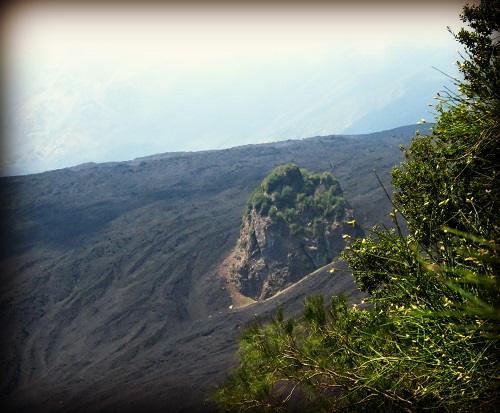Valle del Bove means the “valley of the ox” but nobody knows the origin of this name. This valley is a great depression on the eastern flank of Mt Etna. It opened maybe 64.000 years ago, after the collapsing of the ancient craters – so called “Trifoglietto system” – due to the subsidence of the eastern part of the volcano. The caldera of Valle del Bove was the result: it is 5 km wide and 1 km deep. As the Trifoglietto craters disappeared, the lava found new way out through the craters that today are the main craters of Etna.
Information about the Valley del Bove
A real valley, a huge lava desert, Valle del Bove still collects Etna’s eruption’s lavas today. In its panorama of dark lava rock, a few interesting elements make the landscape unique. Mount Calanna, to the east, ends up to the Salto della Giumenta pass, which used to connect the main valley to Calanna valley. Today, Calanna does not exist anymore, erased by the eruption of 1993.
 the Rocca Musarra in Valle del Bove
the Rocca Musarra in Valle del Bove
Among other hills you can admire inside the Valle del Bove: Serra Gianicola peaks, the Centenari Mountains, Mt Simone and the remainings of the Trifoglietto. Two beautiful and wild rocks, rich in vegetation, stand alone in the valley: Rocca Musarra and Rocca Capra. On the edges of the valley there are many panoramic points tourists love very much: Mt Zoccolaro and Schiena dell’Asino (south), Mt Fontana (east), Pizzi Deneri and Mt Scorsone (north).
Itineraries to follow
Valle del Bove is a fascinating and almost alien place, touristically interesting. But it is not always recommended to go there, because the volcanic phenomena of the summit craters are unpredictable. Although it is a wide and deep valley, no shelter can be found in time from events such as ash clouds, pyroclastic flows or earthquakes.
So, if you want to follow itineraries in this place, do it with reliable guides, in periods of absolute safety and on recommended routes only. Among the most beautiful: the Pietra Cannone route, which from the village of Milo takes you over the edge of the valley. You will admire rock formations with incredible shapes on a 2 and a half hour walk (round trip). Starting from Zafferana Etnea you arrive in what was once Val Calanna, on a 4 hours and 10 minutes walk (round trip).
Starting from Milo, with just over an hour’s walk to get there, you will reach the foot of Rocca Capra, an ancient witness to the ancestor of the modern volcano. Recently some people also have fun in going down to Valle del Bove by using the gullies full of volcanic sand. You go up to a high altitude, in the Montagnola area, and then you let yourself slide on the sand to the valley bottom. The bravest try the same route with mountain bikes or snowboard!
How to reach the Valley del Bove
You can only reach Valle del Bove on foot, or by bike, through these and other itineraries proposed by tour operators and nature guides. The traditional accesses are from Milo, Zafferana and Montagnola (municipality of Nicolosi). To arrive, you will have to drive – from Catania or Messina – the A18 motorway, exit at Giarre or Acireale and then follow the signs for Milo or Zafferana Etnea. To get to the cableway that will take you to the Montagnola, driva along the SP92 road from Nicolosi. The reference airport for those arriving from afar is always Fontanarossa di Catania. (photos by G.Musumeci)